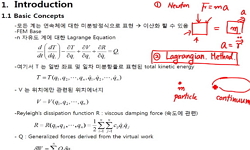초기 재령의 매스콘크리트는 양생과정에서 높은 온도를 유발한다. 수화열 저감 기법 중 내부구속이 지배적인 구조물에서 단면의 내외부 온도차를 관리하는 방식은 그 활용도가 매우 높다. ...
http://chineseinput.net/에서 pinyin(병음)방식으로 중국어를 변환할 수 있습니다.
변환된 중국어를 복사하여 사용하시면 됩니다.
- 中文 을 입력하시려면 zhongwen을 입력하시고 space를누르시면됩니다.
- 北京 을 입력하시려면 beijing을 입력하시고 space를 누르시면 됩니다.
https://www.riss.kr/link?id=A100165498
- 저자
- 발행기관
- 학술지명
- 권호사항
-
발행연도
2008
-
작성언어
Korean
-
주제어
냉각파이프 ; 유한요소법 ; 가열파이프 ; 매스콘크리트 ; 열경사조절 ; Cooling pipe ; Finite element method ; Heating pipe ; Mass concrete ; Thermal gradient control
-
KDC
540
-
등재정보
KCI등재
-
자료형태
학술저널
-
수록면
164-172(9쪽)
-
KCI 피인용횟수
3
- 제공처
-
0
상세조회 -
0
다운로드
부가정보
국문 초록 (Abstract)
초기 재령의 매스콘크리트는 양생과정에서 높은 온도를 유발한다. 수화열 저감 기법 중 내부구속이 지배적인 구조물에서 단면의 내외부 온도차를 관리하는 방식은 그 활용도가 매우 높다. 그러나 수화 균열을 예방하기위해 열경사를 조절하는 현재의 제한적인 방법은 콘크리트 중심과 표면 사이에 미세하거나 거대한 균열을 유발할 수 있다. 특히 냉각파이프를 이용하는 방법은 온도의 상승시에는 적용될 수 있지만, 내외부 온도차이가 심한 온도하강시의 대책으로는 적합하지 않다. 따라서 이 문제에 대한 해결방안으로 가열파이프를 동시에 사용하는 모델을 제안하여 유한요소법으로 해석하였다. 해석 결과, 제안된 냉각파이프와 가열파이프를 동시에 사용하는 방법이 열경사조절에 가장 효과적이며 이를 통해 온도균열을 효과적으로 제어할 수 있을 것으로 판단된다.
다국어 초록 (Multilingual Abstract)
The heat of hydration for early aged mass concrete induces high temperature with the hydration. Control of the temperature difference across a section is an effective strategy to minimize the hydration heat induced cracks for the structures where inte...
The heat of hydration for early aged mass concrete induces high temperature with the hydration. Control of the temperature difference across a section is an effective strategy to minimize the hydration heat induced cracks for the structures where internal restraint is dominant. The current prevention methods for hydration cracking show some limitations for the control of thermal gradients, and these limitations could make micro and macro cracks in surface and core of concrete. Especially cooling methods can decrease the increasing hydration temperature, but it can not prevent the problem while decreasing temperature. Consequently heating pipes are added simultaneously with the cooling pipes in order to control the temperature gradients between core and surface of the concrete, followed by the finite element analysis (FEA). Based on the FEA, the proposed method using cooling pipe and heating pipes together has been found to be an effective alternative in thermal gradient control, in terms of controlling temperature induced cracks significantly.
참고문헌 (Reference)
1 한국콘크리트학회, "콘크리트표준시방서"
2 윤동용, "철근의 영향을 고려한 수화열 유한요소해석" 한국콘크리트학회 17 (17): 43-49, 2005
3 김상철, "매스콘크리트 구조물에서 파이프쿨링을 고려한 수화열 해석" 10 (10): 922-927, 1998
4 Segerlind L. J., "Applied finite element analysis" Wiley Text Books 1984
5 "American Concrete Institute"
1 한국콘크리트학회, "콘크리트표준시방서"
2 윤동용, "철근의 영향을 고려한 수화열 유한요소해석" 한국콘크리트학회 17 (17): 43-49, 2005
3 김상철, "매스콘크리트 구조물에서 파이프쿨링을 고려한 수화열 해석" 10 (10): 922-927, 1998
4 Segerlind L. J., "Applied finite element analysis" Wiley Text Books 1984
5 "American Concrete Institute"
동일학술지(권/호) 다른 논문
-
구조물의 표면마감 특성이 해양콘크리트의 내구성에 미치는 영향
- 한국구조물진단유지관리공학회
- 박상준
- 2008
- KCI등재
-
황산마그네슘 침식을 받은 실리카 퓸 혼합 시멘트 경화체의 성능저하에 대한 미세구조적 관찰
- 한국구조물진단유지관리공학회
- 이승태
- 2008
- KCI등재
-
외부긴장재로 보강된 강합성보의 극한거동에 대한 실험적 연구
- 한국구조물진단유지관리공학회
- 최동호
- 2008
- KCI등재
-
트러스 철근을 갖는 하프 프리캐스트 슬래브의 휨 내력에 관한 실험적 연구
- 한국구조물진단유지관리공학회
- 서태석
- 2008
- KCI등재
분석정보
인용정보 인용지수 설명보기
학술지 이력
| 연월일 | 이력구분 | 이력상세 | 등재구분 |
|---|---|---|---|
| 2027 | 평가예정 | 재인증평가 신청대상 (재인증) | |
| 2021-01-01 | 평가 | 등재학술지 유지 (재인증) |  |
| 2018-01-01 | 평가 | 등재학술지 유지 (등재유지) |  |
| 2015-01-01 | 평가 | 등재학술지 유지 (등재유지) |  |
| 2012-01-26 | 학회명변경 | 영문명 : Journal Of The Korea Institute For Structural Maintenance Inspection -> The Korea Institute For Structural Maintenance and Inspection |  |
| 2012-01-19 | 학술지명변경 | 한글명 : 구조물진단학회지 -> 한국구조물진단유지관리공학회 논문집외국어명 : Journal of The Korea Institute for Structural Maintenance Inspection -> Journal of The Korea Institute for Structural Maintenance and Inspection |  |
| 2011-01-01 | 평가 | 등재학술지 유지 (등재유지) |  |
| 2009-01-01 | 평가 | 등재학술지 유지 (등재유지) |  |
| 2007-08-13 | 학회명변경 | 한글명 : 한국구조물진단학회 -> 한국구조물진단유지관리공학회 |  |
| 2007-04-11 | 학회명변경 | 한글명 : (사)한국구조물진단학회 -> 한국구조물진단학회 |  |
| 2007-01-01 | 평가 | 등재학술지 유지 (등재유지) |  |
| 2004-01-01 | 평가 | 등재학술지 선정 (등재후보2차) |  |
| 2003-01-01 | 평가 | 등재후보 1차 PASS (등재후보1차) |  |
| 2001-07-01 | 평가 | 등재후보학술지 선정 (신규평가) |  |
학술지 인용정보
| 기준연도 | WOS-KCI 통합IF(2년) | KCIF(2년) | KCIF(3년) |
|---|---|---|---|
| 2016 | 0.36 | 0.36 | 0.31 |
| KCIF(4년) | KCIF(5년) | 중심성지수(3년) | 즉시성지수 |
| 0.28 | 0.27 | 0.496 | 0.13 |




 ScienceON
ScienceON 코리아스칼라
코리아스칼라






